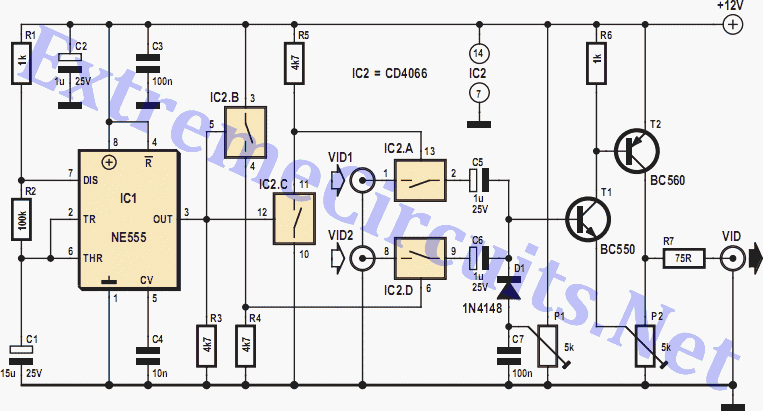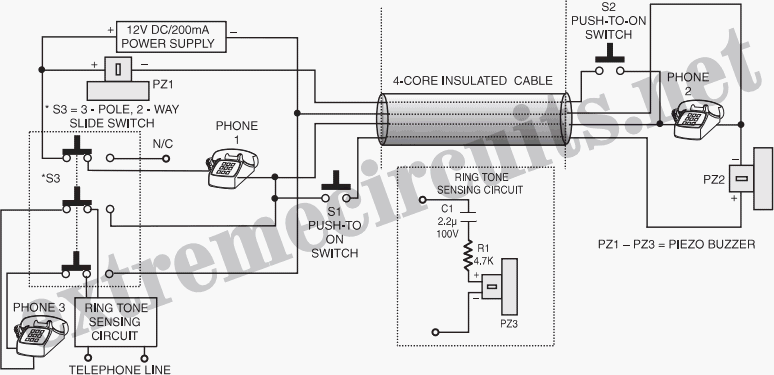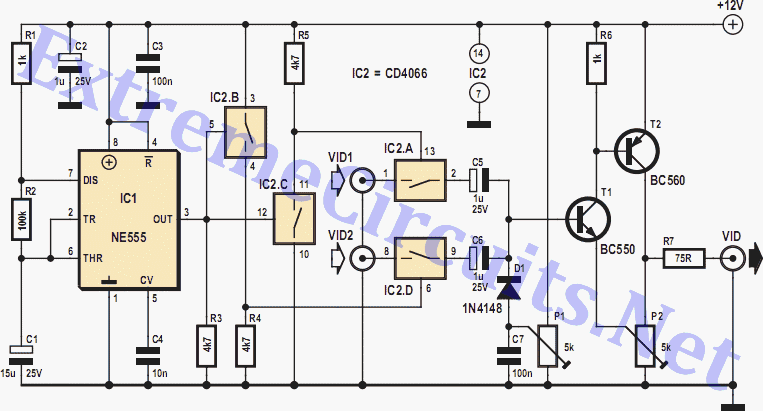
Two-Wire Intercom

The design consists of an amplifier, a double-pole changeover switch, and two loudspeakers: one for the master station and one for the slave. More than one slave unit can be used, but each requires an additional changeover switch. The power amplifier is a Type LM384, which can provide almost 2 W output at a supply voltage of 15 V. Pins 3, 4, 5, 10, 11, and 12 are connected to ground and at the same time afford some cooling of the device. Because of that, the IC should not be fitted in a socket, but be soldered direct to the circuit board. The LM384 processes signals with respect to earth so that an asymmetric supply is sufficient. The amplification has been set internally to 50 (34 dB). The IC's supply line is decoupled by C9. To ensure adequate input sensitivity, a preamplifier, IC1, is provided, which has an amplification of 11 (21 dB). Because this stage is intended for speech only, its bandwidth is limited to 160 Hz to 10 kHz. Divider R2/R3 at the input of the op amp is decoupled by C3. Special loudspeakers that can also serve as microphones are readily available: in the prototype, MS-55 units from Monacor were used, but a number of other makes will do just as well. The bandwidth of the MS-55 (used as loudspeaker) extends from 150 Hz to 20 kHz and (used as a microphone) from 20 Hz to 20 kHz. The MS-55 can handle up to 5 W output. To ensure satisfactory operation, particularly as a microphone, the loudspeaker must be fitted in a closed box. Although it is advantageous for the microphone to have a low internal resistance, it is necessary for a transformer to be used at the input of the circuit. This has, however, the advantage that long cables can be used. The present circuit uses a standard mains transformer instead of a special microphone transformer. For this purpose, the secondary (6 V) winding is connected to the microphone. The microphone impedance is thereby magnified from about 8 to around 10 k. The power handling of the transformer is quite high to ensure that signal losses in the primary winding are kept at a minimum. Capacitor C1 suppresses HF interference. If the mains transformer and the microphone transformer are housed in the same enclosure, some trial and error and screening are necessary to eliminate hum. The microphone transformer itself might cause hum in the remainder of the circuit. In that case, the preamp stage must also be screened. In the prototype, the speech bandwidth was limited from 400 Hz to 4 kHz, and this proved perfectly acceptable for good speech transfer. Most of the current drawn by the circuit flows through the power amplifier. At worst, this is 210 mA (680 mA peak) when the amplifier delivers 1.8 W output. The LM384 can deliver a power of up to 5 W. The supply voltage should then be raised to 22 V and a heatsink for the device will be necessary.
This electronic design features an audio amplification system comprising an LM384 power amplifier, a double-pole changeover switch, and dual loudspeakers—one designated for the master station and the other for the slave station. The system is designed to accommodate multiple slave units, each requiring an additional changeover switch for operation. The LM384 amplifier is capable of delivering nearly 2 watts of output power when supplied with a voltage of 15 volts. To optimize thermal management, several pins (3, 4, 5, 10, 11, and 12) are connected to ground, facilitating effective heat dissipation. The amplifier chip should be directly soldered to the circuit board instead of being mounted in a socket to enhance reliability.
The LM384 is designed to process audio signals with respect to ground, allowing for operation with an asymmetric power supply. Internally, the amplifier is configured for a gain of 50 (equivalent to 34 dB). Signal decoupling is achieved through capacitor C9, which stabilizes the supply line. To improve input sensitivity, a preamplifier (IC1) with a gain of 11 (21 dB) is included in the design. This preamp is specifically tailored for speech applications, limiting its operational bandwidth to between 160 Hz and 10 kHz. Additionally, a resistor divider (R2/R3) at the input of the operational amplifier is decoupled by capacitor C3 to maintain signal integrity.
The system utilizes specialized loudspeakers that can function as microphones, with the prototype employing Monacor's MS-55 units. These loudspeakers have a frequency response ranging from 150 Hz to 20 kHz when used as speakers, and from 20 Hz to 20 kHz when used as microphones. The MS-55 can handle power levels up to 5 watts, necessitating installation within a closed enclosure to ensure optimal microphone performance. A transformer is employed at the circuit's input to facilitate the connection of long cables, enhancing flexibility in installation. A standard mains transformer is utilized instead of a dedicated microphone transformer, with the secondary (6 V) winding connected to the microphone. This configuration increases the microphone impedance from approximately 8 ohms to around 10 k ohms, minimizing signal loss in the primary winding due to the transformer’s high power handling capabilities.
To mitigate high-frequency interference, capacitor C1 is incorporated into the design. If both the mains transformer and the microphone transformer are housed together, careful screening and empirical adjustments are necessary to eliminate potential hum issues. The microphone transformer may introduce noise into the circuit, necessitating additional shielding for the preamplifier stage. The prototype's speech bandwidth has been effectively limited to between 400 Hz and 4 kHz, ensuring clear audio transmission. The circuit's current draw primarily occurs through the power amplifier, which can reach a maximum of 210 mA (with peak currents of 680 mA) when delivering 1.8 watts of output. The LM384 has the capability to provide up to 5 watts of power; however, this would require an increase in supply voltage to 22 volts and the inclusion of a heatsink for thermal management. The design consists of an amplifier, a double-pole changeover switch and two loudspeakers: one for the master station and one for the slave. More than one slave unit can be used, but each requires an additional changeover switch. The power amplifier is a Type LM384, which can provide almost 2 W output at a supply voltage of 15 V. Pins 3, 4, 5, 10, 11, and 12 are connected to ground and at the same time afford some cooling of the device.
Because of that, the IC should not be fitted in a socket, but be soldered direct to the circuit board. The LM384 processes signals with respect to earth so that an asymmetric supply is sufficient. The amplification has been set internally to 50 (34 dB). The IC"s supply line is decoupled by C9. To ensure adequate input sensitivity, a preamplifier, IC1, is provided, which has an amplification of 11 (21 dB).
Because this stage is intended for speech only, its bandwidth is limited to 160 Hz to 10 kHz. Divider R2/R3 at the input of the op amp is decoupled by C3. Special loudspeakers that can also serve as microphones are readily available: in the prototype, MS-55 units from Monacor were used, but a number of other makes will do just as well. The bandwidth of the MS-55 (used as loudspeaker) extends from 150 Hz to 20 kHz and (used as a microphone) from 20 Hz to 20 kHz.
The MS-55 can handle up to 5-W output, lb ensure satisfactory operation, particularly as a microphone, the loudspeaker must be fitted in a closed box. Although it is advantageous for the " "microphone"" to have a low internal resistance, it is necessary for a transformer to be used at the input of the circuit.
This has, however, the advantage that long cables can be used. The present circuit uses a standard mains transformer instead of a special microphone transformer. For this purpose, the secondary (6 V) winding is connected to the "microphone." The microphone impedance is thereby magnified from about 8 to around 10 k. The power handling of the transformer is quite high to ensure that signal losses in the primary winding are kept at a minimum.
Capacitor CI suppresses HF interference. If the mains transformer and the "microphone transformer" are housed in the same enclosure, some trial and error and screening are necessary to eliminate hum. The "microphone transformer" itself might cause hum in the remainder of the circuit. In that case, the preamp stage must also be screened. In the prototype, the speech bandwidth was limited from 400 Hz to 4 kHz and this proved perfectly acceptable for good speech transfer.
Most of the current drawn by the circuit flows through the power amplifier. At worst, this is 210 mA (680 mA peak), when the amplifier delivers 1.8-W output. The LM384 can deliver a power of up to 5 W. The supply voltage should then be raised to 22 V and a heatsink for the device will be necessary.
This electronic design features an audio amplification system comprising an LM384 power amplifier, a double-pole changeover switch, and dual loudspeakers—one designated for the master station and the other for the slave station. The system is designed to accommodate multiple slave units, each requiring an additional changeover switch for operation. The LM384 amplifier is capable of delivering nearly 2 watts of output power when supplied with a voltage of 15 volts. To optimize thermal management, several pins (3, 4, 5, 10, 11, and 12) are connected to ground, facilitating effective heat dissipation. The amplifier chip should be directly soldered to the circuit board instead of being mounted in a socket to enhance reliability.
The LM384 is designed to process audio signals with respect to ground, allowing for operation with an asymmetric power supply. Internally, the amplifier is configured for a gain of 50 (equivalent to 34 dB). Signal decoupling is achieved through capacitor C9, which stabilizes the supply line. To improve input sensitivity, a preamplifier (IC1) with a gain of 11 (21 dB) is included in the design. This preamp is specifically tailored for speech applications, limiting its operational bandwidth to between 160 Hz and 10 kHz. Additionally, a resistor divider (R2/R3) at the input of the operational amplifier is decoupled by capacitor C3 to maintain signal integrity.
The system utilizes specialized loudspeakers that can function as microphones, with the prototype employing Monacor's MS-55 units. These loudspeakers have a frequency response ranging from 150 Hz to 20 kHz when used as speakers, and from 20 Hz to 20 kHz when used as microphones. The MS-55 can handle power levels up to 5 watts, necessitating installation within a closed enclosure to ensure optimal microphone performance. A transformer is employed at the circuit's input to facilitate the connection of long cables, enhancing flexibility in installation. A standard mains transformer is utilized instead of a dedicated microphone transformer, with the secondary (6 V) winding connected to the microphone. This configuration increases the microphone impedance from approximately 8 ohms to around 10 k ohms, minimizing signal loss in the primary winding due to the transformer’s high power handling capabilities.
To mitigate high-frequency interference, capacitor C1 is incorporated into the design. If both the mains transformer and the microphone transformer are housed together, careful screening and empirical adjustments are necessary to eliminate potential hum issues. The microphone transformer may introduce noise into the circuit, necessitating additional shielding for the preamplifier stage. The prototype's speech bandwidth has been effectively limited to between 400 Hz and 4 kHz, ensuring clear audio transmission. The circuit's current draw primarily occurs through the power amplifier, which can reach a maximum of 210 mA (with peak currents of 680 mA) when delivering 1.8 watts of output. The LM384 has the capability to provide up to 5 watts of power; however, this would require an increase in supply voltage to 22 volts and the inclusion of a heatsink for thermal management. The design consists of an amplifier, a double-pole changeover switch and two loudspeakers: one for the master station and one for the slave. More than one slave unit can be used, but each requires an additional changeover switch. The power amplifier is a Type LM384, which can provide almost 2 W output at a supply voltage of 15 V. Pins 3, 4, 5, 10, 11, and 12 are connected to ground and at the same time afford some cooling of the device.
Because of that, the IC should not be fitted in a socket, but be soldered direct to the circuit board. The LM384 processes signals with respect to earth so that an asymmetric supply is sufficient. The amplification has been set internally to 50 (34 dB). The IC"s supply line is decoupled by C9. To ensure adequate input sensitivity, a preamplifier, IC1, is provided, which has an amplification of 11 (21 dB).
Because this stage is intended for speech only, its bandwidth is limited to 160 Hz to 10 kHz. Divider R2/R3 at the input of the op amp is decoupled by C3. Special loudspeakers that can also serve as microphones are readily available: in the prototype, MS-55 units from Monacor were used, but a number of other makes will do just as well. The bandwidth of the MS-55 (used as loudspeaker) extends from 150 Hz to 20 kHz and (used as a microphone) from 20 Hz to 20 kHz.
The MS-55 can handle up to 5-W output, lb ensure satisfactory operation, particularly as a microphone, the loudspeaker must be fitted in a closed box. Although it is advantageous for the " "microphone"" to have a low internal resistance, it is necessary for a transformer to be used at the input of the circuit.
This has, however, the advantage that long cables can be used. The present circuit uses a standard mains transformer instead of a special microphone transformer. For this purpose, the secondary (6 V) winding is connected to the "microphone." The microphone impedance is thereby magnified from about 8 to around 10 k. The power handling of the transformer is quite high to ensure that signal losses in the primary winding are kept at a minimum.
Capacitor CI suppresses HF interference. If the mains transformer and the "microphone transformer" are housed in the same enclosure, some trial and error and screening are necessary to eliminate hum. The "microphone transformer" itself might cause hum in the remainder of the circuit. In that case, the preamp stage must also be screened. In the prototype, the speech bandwidth was limited from 400 Hz to 4 kHz and this proved perfectly acceptable for good speech transfer.
Most of the current drawn by the circuit flows through the power amplifier. At worst, this is 210 mA (680 mA peak), when the amplifier delivers 1.8-W output. The LM384 can deliver a power of up to 5 W. The supply voltage should then be raised to 22 V and a heatsink for the device will be necessary.





